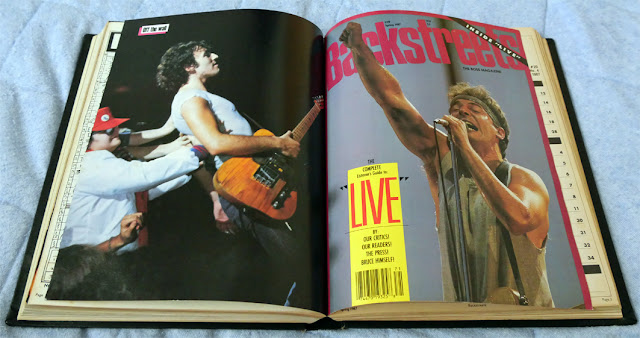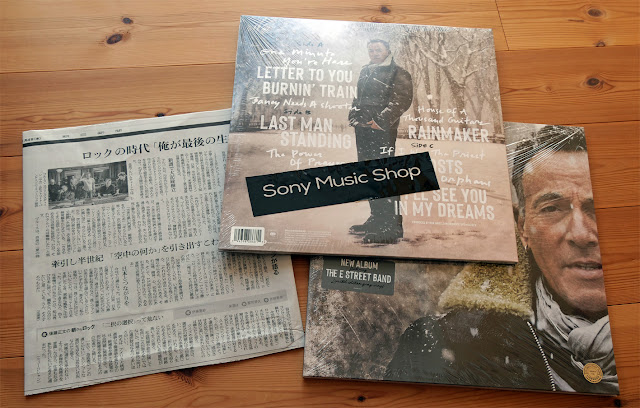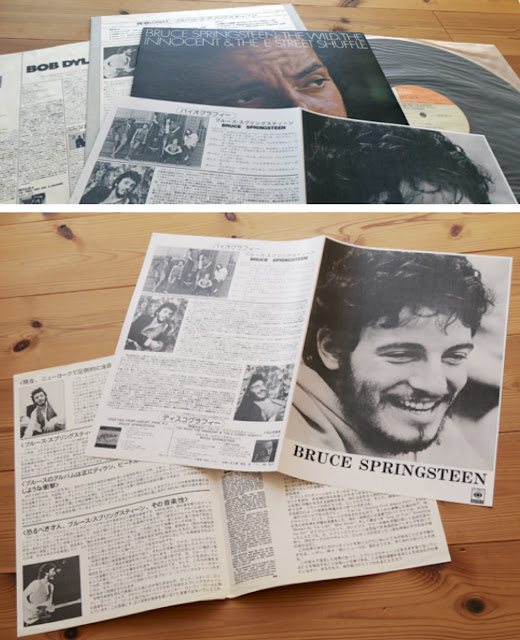 |
| A boxed description on each OBI (encircled) provides a clue to which color strip came earlier. |
- First, I do remember that I saw the red-OBI copies exclusively and none of the gold versions at a retail shop when I bought my first copy on the release day (Nov. 9th, 1986).
- Second, an ex-company staff at CBS/SONY back then in charge of Springsteen recalled "red-OBI first" in his blog a few years ago when he wrote about the hectic days around the extraordinary rapid manufacture and subsequent immediate release of the box set, not to fall behind the U.S. release. He was previously mentioned in this blog (04/26/2015).
- Third, OBI is a target for cost reduction in offset printing, and normally, using multiple colors is rare (e.g., the DARKNESS OBI; see 03/05/2016). Metallic gold also costs high because it is not a CYMK-process color but a spot (solid) color that must be pre-mixed and used in a single run. The company probably adopted the red OBI (less gold/less cost) for the initial run to save production costs and see how the sale went on.
- Fourth, the color scheme aside, the two versions of OBI strips show a few noticeable differences. There is a boxed description at the lower part on the backside of the red OBI, which says something like, "The photo booklet (referring to the original English booklet) and liner notes (meaning the Japanese booklet) are not included in the box and handed to the customers at retail shops." This allowed the manufacturing process to be shortened, explaining why the company was able to ship the first run so quickly to the retails in order to compete with the imported copies in domestic markets (see Part 1). The gold OBI deletes the description that was unnecessary for the second run (that needed no rush to be released). Instead, it has another short text in a box saying, "With the original photobook and lyric & liner notes," on the front face.
- Finally, when SONY MUSIC (Japan) reissued in 2005 the 17-CD titles with the replica paper LP sleeves, it was the red OBI that was recreated with the miniature box set (MHCP 729-733; see the picture immediately below). This reissue project faithfully reproduced an original sleeve and OBI of the first press for each title, if you remember. Just for your information, although SONY released for the first time LP-style CD reissues back in 1999, their mini-OBI strips did not necessarily mirror the original ones [for example, the GREETINGS CD (SRCS 9466) recreated the famous wrap-around OBI used for the second pressing].
Are these enough? In contrast to the vinyl box, the CD edition (75DP 700-702) was originally released with a gold OBI (see the last image on Part 1), just like the second vinyl issue, which might be a major cause of confusion, especially to overseas collectors. By the way, some years ago, I communicated and discussed on this topic with Eddy (of Springsteen lyrics). Taking this opportunity, I thank him for his insights and thoughtful discussion.
 |
| The LIVE box was reissued twice in Japan in 1999 (3-CD format; SONY SRCS 8985-8987) and 2005 (5-CD; MHCP 729-733; upper right corner), with an elaborate miniature paper sleeve of the original LP form. Both reissues feature red OBI strips, although they are slightly different in their design. Note that the second wave of the 1999 reissue project (BORN IN THE U.S.A. to THE GHOST OF TOM JOAD) was ceased at the request of Springsteen's management, and the seven reissue titles, including this one, were hastily withdrawn that fall. The project abortion forced the pre-order at the Backstreets Records (see the flyer) to be canceled. Since then, these CDs have become extremely rare collectibles (see the previous post on 09/10/2016). The 1999 issue shown in the image includes three CDs, three inner sleeves, and two booklets. |
 |
| In my opinion, the promotional copies for the LIVE box is the hardest to come by among those with the red "sample" labels for the original albums released in the 1980s. |
— To be continued to Part 3.






